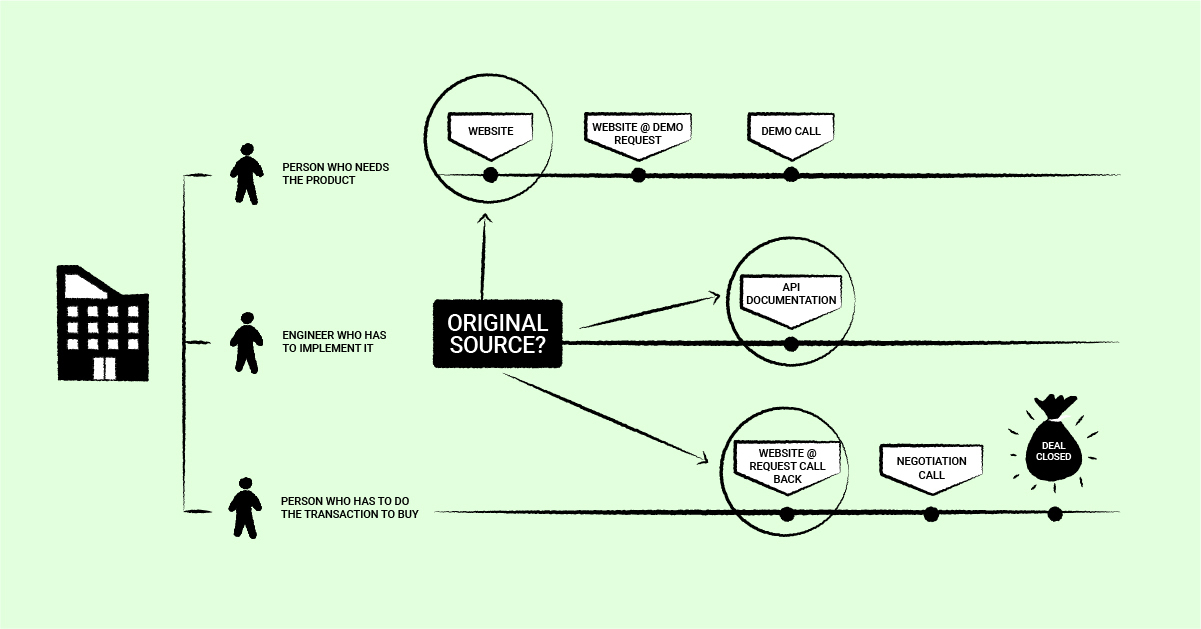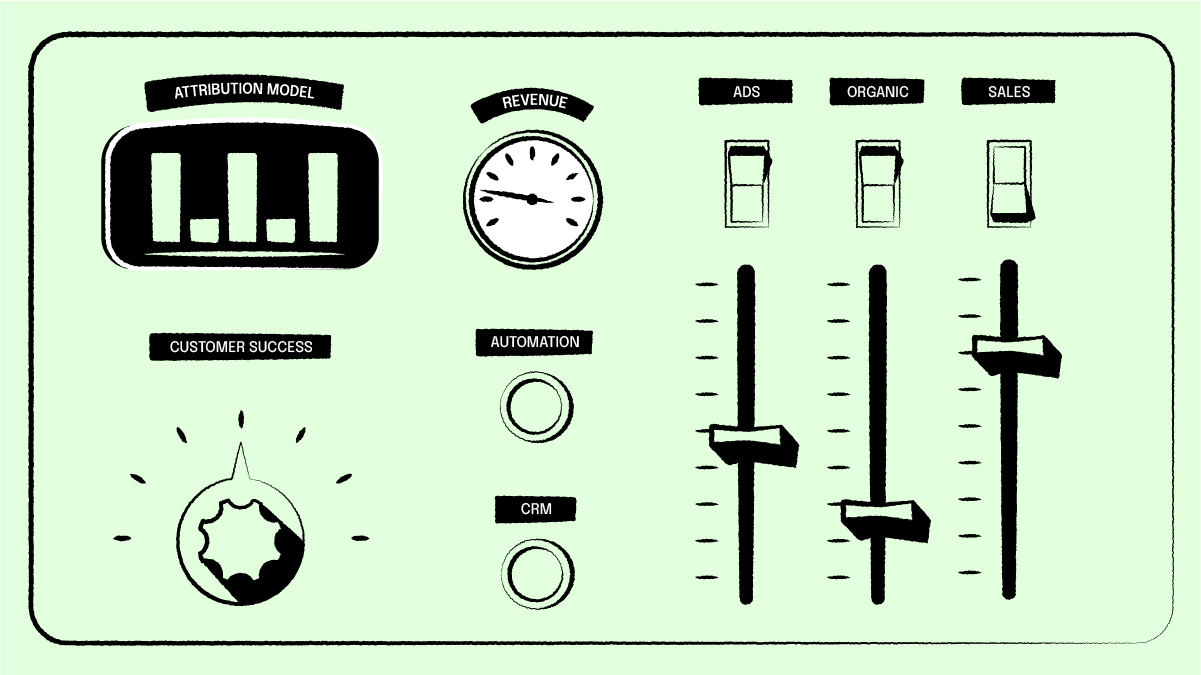Most sales reps are familiar with the term attribution.
In fact, many are probably using first-touch attribution to learn where their leads came from via their CRM’s ‘original’ or ‘lead’ source field.
So it is little surprise to see sales thought leaders, such as Tito Bohrt, conjuring up attribution models that better and more fairly accommodate both marketing and sales activities.
However, attribution carries the stigma, particularly in sales circles, of a marketing-only space. In fact, because of this, the sales community continues to view attribution with some suspicion. At best it’s dismissed as “another marketing tool”; at worst it’s bitterly rejected as “that wizardry marketers use to claim credit for deals”.
Too often is the immense utility of (revenue) attribution for sales overlooked. What’s more, sales teams will continue missing out on the benefits of attribution for as long as marketing continues to overshadow the category.
This article seeks to dismantle the notion that attribution is a marketing-only space and layout why sales reps need to be making the case for revenue attribution.
Not marketing, but revenue attribution
Attribution is the process of tracking, analyzing, and measuring touch points across buyer journeys. Yet, while marketers have used attribution to successfully measure and optimize activities throughout their funnel, sales teams have remained satisfied with their CRM.
The resulting silos have been to the detriment of both teams.
B2B deals are closed through months-long team effort consisting of quality ads, thought-provoking content, impactful product demos, and killer sales meets.
Attributing only some of these touches means failing to get the complete picture of the B2B customer journey.
For this reason, both marketing and sales need to be looking at doing revenue and not marketing attribution. That is: you need to make sure your business buys or builds an attribution tool that captures and handles all the touchpoints that take place in the B2B customer journey.
Ingredients for revenue attribution
Revenue attribution consists of three crucial elements:
1. Multi-touch
Revenue attribution tracks all of an account’s recordable touches. This is as much on the sales front (phone calls, social media messaging, emails) as on the marketing front (ad clicks, content views, form fills).
Revenue attribution achieves this by tracking everything that users are doing on your site and integrating with the tools sitting on your tech stack – a particular treat for Sales Ops.
By tracking and identifying users and accounts, multi-touch attribution models allow you to attribute credit to any and all the activities that are associated with the account’s journey.
This contrasts from the single-touch, single source attribution your CRM uses for the ‘original source’ or ‘lead source’ field which carves out only a narrow picture of everything that’s taking place in the customer journey.

2. Multi-stakeholder (account-based)
We know that the typical B2B customer is not a single individual but a company (account) consisting of multiple stakeholders.
Each of these may interact with your activities in different ways and help drive the deal down the funnel. For instance, the person in need of the product is not necessarily the one who will be signing the check, nor is she likely to be the person implementing your product.
A B2B revenue attribution solution is therefore configured to accommodate all identified stakeholders. This allows the success of activities to be measured on an individual and account basis.

3. Multiple and customizable attribution models
Finally, an effective revenue attribution solution will be able to run the data through different attribution models.
Multi-touch attribution models, unlike single-touch, distribute value across the account’s multiple touches. But how this value is weighted changes depending on the model applied.
For example, a linear multi-touch model will attribute equal credit to all touches. Whereas a W model will give the first, middle, and last touches greater credit than those occurring in between. The model you end up using depends entirely on your unique needs. Which is why it’s important for the revenue attribution tool to facilitate custom models.
Being able to compare models allows teams to identify which events led to revenue and when. For instance, the linear model will pick up which of your activities helped generate revenue in a given deal. However, you’ll need a U model to identify which performed best in acquiring the lead and sealing the deal.
Firing up your sales efforts with revenue attribution
Ok, so revenue attribution makes getting a holistic and fair overview of the end-to-end customer journey possible. But how exactly will this help a sales team perform better in practical terms?
There are three broad ways revenue attribution helps in practice, each of which offers notable competitive advantages.
Inbound efforts
Going into conversations without a clear picture of how the account came through the funnel and what they’ve interacted with can make it very difficult to adequately tailor the conversation.
Let’s use a hypothetical example. A number of contacts within an account may have read a blog post on one of your product’s features. They also attended a webinar on the same topic and looked at the same product feature page on your site.
Not only is this feature going to be the segue for your conversation, but you’re also going to assume some knowledge on their part, meaning you can dive deeper into some of the less well-known details of this feature and how this interacts with other killer features. In short, with what in effect should be a much more qualified lead, you’re going to be closer to closing the deal.
Outbound efforts
Having an overview of how accounts have progressed through the funnel, inclusive of all the juicy data on each contact’s touches, will go a very long way in fine tuning personas, sequences, and messages.
Say the data shows that ops people in most of your journeys have engaged with a particular blog post. Sending a cold message to an ops persona which includes a link might prove more successful.
Performance
At its core, attribution is about identifying what’s working and what isn’t. In having all revenue-generating touches thrown into the modeling, you can begin to unpack where your activities are falling short.
Let’s say an account goes cold and your emails and calls are going unanswered. Yet the account eventually reheats, seemingly out-of-the-blue. Through the revenue attribution modeling, you’d be able to identify that it was in fact a retargeting ad that brought the account back to life. You want to be seeing and accounting for these episodes. If it’s recurring, you want to evaluate what your activities might be leading to accounts going cold.
Revenue attribution for sales ops
But it’s not just front line sales teams that want to be looking to bring revenue attribution on board. Sales Ops can benefit, too.
A revenue attribution tool offers Sales Ops a one-stop shop for data and metrics on the end-to-end customer journey. This means having all the data cleaned and ready for sales BI, a clearer understanding of lead generation (within a multi-touch, multi-stakeholder framework), an overview of sales’ performance within the wider buyer journey, and improved forecasting and strategic planning.

Let’s unpack these a little:
- Unified data from across the techstack. With revenue attribution Sales Ops are able to centralize control over their sales techstack. All the data from across tools, whether CRM, automation, or call software – clean and in one place. This means the Sales Ops professional will spend less time sorting through different field labels and focusing on finessing processes and optimizing efforts.
- Lead generation. Revenue attribution enables Sales Ops to find how effectively leads are being generated. This includes not only sales outbound efforts and lead generation, but also how successful marketing is at generating qualified leads. This further helps dismantle ineffective marketing-sales siloing.
- Performance. Revenue attribution links sales (and marketing) efforts directly to revenue. Additionally, most, if not all, off-the-shelf tools will also bring a comprehensive analytics package, where you can measure and compare all efforts and KPIs under one roof.
- Forecasting and strategic planning. With revenue attribution, you can build a much more accurate picture not only of your sales forecasts, but also the channels that lead to sales. You will also have a clearer picture of your average customer journey length or time-to-revenue. Moreover, with the historical data from across the journey you’ll be much better placed to allocate resources for future activities and campaigns.
You’re ready to make the case for revenue attribution
In the hyper-digital B2B space, there is little room for siloed pipelines. There needs to be a complete understanding of what’s happening across the entirety of the customer journey, and crucially, what’s helping drive revenue and when. Attribution delivers this solution.
For the sales team, attribution means:
- Better tailored sales conversations
- Fine tuned personas, sequences and messaging
- Improved company-wide revenue-generating machinery
- Making sales ops’ lives easier
But to usher in these benefits attribution needs to shake off the marketing stigma and embrace the complete revenue-generating process – encompassing all the touches taking place in the B2B buyer journey, from first click to closed as won.The first step is making the case for revenue attribution



